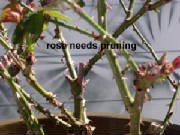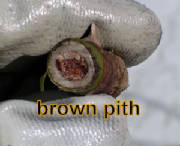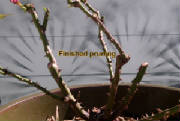|
|
 |
|
Gardening Blog
|
 |
|
|
Tuesday, February 9, 2010
Spring Rose Care
If you have roses in your landscape, the spring chores of pruning, fertilizing and mulching need to be started in
February. 
Pruning is first ‑ choose
three to five (more if your rose is older) healthy large green canes, then prune out all of the small spindly canes. Also
remove those that grow in toward the center of the plant or are rubbing other canes. Hybrid Tea roses need good air circulation
to discourage diseases. This is not quite as important on shrub and other rose varieties.  On each cane, choose an outward facing bud and prune at a 45 degree angle about 1/4 inch above the bud. Prune to healthy wood
‑ green bark on the cane and white pith core revealed with the On each cane, choose an outward facing bud and prune at a 45 degree angle about 1/4 inch above the bud. Prune to healthy wood
‑ green bark on the cane and white pith core revealed with the pruning cut. If the pith is brownish ‑ prune further down or remove the cane all together. The American Rose Society
recommends covering the cut surfaces where you prune with white glue to discourage boring insects. pruning cut. If the pith is brownish ‑ prune further down or remove the cane all together. The American Rose Society
recommends covering the cut surfaces where you prune with white glue to discourage boring insects.
Fertilizer is very important for lovely roses in our area. A commercial fertilizer with a ratio
of 3 N ‑ 1 P ‑ 2 K that also includes Magnesium and has at least 50% of the Nitrogen as a slow release form is
a good choice. Some rose references recommend adding bone meal or superphosphate to the soil at planting and then again in
the spring, but we already have sufficient phosphorus in the soil in Pinellas County, so adding this might lead to toxicity
for the plant. You can find special rose fertilizer, but be cautious if the second number is very high. If you are growing
your roses in containers with potting soil, you do need to be more concerned with adding sufficient phosphorus. We do need
to fertilize about 6 times in our area during the growing season. ½ cup of Epsom salts per plant will add needed Magnesium
if the fertilizer does not contain it.
Applying
an organic mulch always helps to reduce the loss of soil moisture, keeps down weeds that compete for nutrients and helps keep
the temperature of the soil constant. It is necessary to clean up all leaves, canes and other debris around the roses to remove
the fungal spores that over wintered and cause the dreaded black spot and other fungal diseases on the leaves before you put
down fresh mulch. Remember to keep the mulch away from the base of the plant and the bud graft union (the swollen area where
canes grow from). Removing all of the green  foliage with this spring pruning can reduce fungal spores that may have survived the winter. foliage with this spring pruning can reduce fungal spores that may have survived the winter.
Many
of the hybrid roses are very susceptible to the fungal disease black spot, especially the hybrid teas. First a yellow spot
forms on the leaf, then the center turns black and eventually the whole leaf dies and falls to the ground. Keep the area
around the roses clean and start a spraying schedule early. There are fungicides for this problem with Neem Oil and Copper
fungicide being the least toxic. The best thing to do is to plant roses that are disease resistant
such as “old garden roses” and shrub roses such as the “Knock-out” series. Then you can just stand
back and admire them. For
additional information, access the University of Florida/IFAS publication Growing Roses in Florida at: http://edis.ifas.ufl.edu/ep339
12:16 pm est
|
|
To subscribe to this blog - click on XML icon.
|
 |
|
|
|
 |
|
|
Pampered Gardeners LLC * Oldsmar, FL * USA * Phone: 727 483-3783 * pam@pamperedgardeners.com
|
|
|
 |

